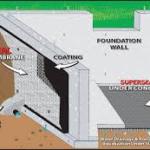Water always flows downhill, and by the easiest route possible. That’s the basic concept behind a French drain, a slightly sloped trench filled with round gravel and a pipe that diverts water away from your house.
Water travels freely through the pipe, which empties a safe distance from the house.
The trench bottom should be sloped about 1 inch for every 8 feet in the direction you want water to flow. A low-lying area of your property, drainage ditch. dry well or the street.
When You Need a French Drain
- When you have a problem with surface water, such as a soggy lawn or a driveway that washes out.
- If you’re building a retaining wall on a hillside.
If Your Problem is Surface Water
Install a shallow French drain. Also called a curtain drain, it extends horizontally across your property, directly uphill of the area you want to dry out. It intercepts water and channels it around the soggy spot.
This type of drain doesn’t have to be very deep – a common size is 2 feet deep and 1.5 feet across. Where the drain passes through areas with trees or shrubs, switch to solid pipe (not perforated) to reduce the risk of roots growing into the piping and clogging it.
Cost: $10 to $16 per linear foot.
If Water is Getting Into Your Basement
Install a deep French drain. Also called a footing drain, it runs around the perimeter of the house at the footing level and intercepts water before it can enter your basement.
It’s easy to install during house construction, but much more difficult and expensive to add later. If you have tall basement walls, you may have to dig down quite a ways to access your foundation footing.
If there’s not enough slope for your drain system to work, you may need to pipe the collected water to a basin in the basement, where a sump pump can lift it and send it to the storm drain system.
Cost: $12,000 for a 1,500-sq.-ft. basement 6 feet deep.
Install an interior French drain. An interior French drain intercepts water as it enters your basement – it’s the surest method of keeping your basement dry and a better option than a footing drain.
However, if you have a finished basement, you’ll have to remove interior walls in order to install the system. That shouldn’t be a problem if water is ruining your basement anyway.
Crews cut a channel around the perimeter of your basement floor, chip out the concrete, and install perforated pipe all the way around. The water flows to a collection tank sunk into the floor, and a sump pump sends it out to the yard or a storm drain.
The channel is patched with a thin layer of concrete, except for a small gap at the edge to catch any water that dribbles down the wall.
Cost: About $3,000.
If You’re Building a Retaining Wall on a Hillside
If you’re building a retaining wall, add a French drain behind the first course of stones or blocks. Otherwise, water moving down the hill will build up behind the wall and undermine it. The pipe should rest on the same compacted gravel base or concrete footing that supports the wall.
To protect the drain from clogging with silt, drape landscape cloth across the base or footing and up the slope before adding the pipe and drain gravel. Near the top of the wall, fold the cloth over the top of the gravel, and top with several inches of soil.
Cost: The added cost to do this while building is very little – just the price of drain gravel ($25 per cubic yard) and pipe (50 cents to $1 per lineal foot).
If you are unsure if a french drain is right for you, contact a licensed drainage contractor before you begin your project.
Need a drainage contractor ? Try M. Leon Construction at 503-643-6631 or Ability Plus Drainage at 503-246-0474.
